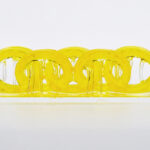Engineers at the University of Virginia School of Engineering and Applied Science are pioneering the use of cellulose nanofibrils (CNF) to enhance 3D-printed concrete. This plant-based material, derived from wood pulp, could make concrete more resilient and environmentally friendly. “The improvements we saw on both printability and mechanical measures suggest that incorporating cellulose nanofibrils in commercial printable materials could lead to more resilient and eco-friendly construction practices sooner rather than later,” said Osman E. Ozbulut, a professor in the Department of Civil and Environmental Engineering.

Innovative Use of Cellulose Nanofibrils
Buildings made of 3D-printed concrete offer quick, precise construction, reduced labor costs, and less waste. However, current printable material options are limited, and their sustainability and durability are often questioned. “We’re dealing with contradictory objectives,” Ozbulut explained. “The mixture has to flow well for smooth fabrication, but harden into a stable material with critical properties, such as good mechanical strength, interlayer bonding, and low thermal conductivity.”
CNF, known in the industry for its renewable and low-impact properties, shows strong potential as an additive. It improves the flow and mechanical strength of cement composites. Before this study, the influence of CNF on 3D-printed composites was unclear.
Research Findings
Ozbulut’s team, including Ph.D. alumnus Ugur Kilic, found that adding at least 0.3% CNF significantly improved flow performance. Microscopic analysis revealed better bonding and structural integrity. Further testing showed CNF-enhanced components withstood pulling, bending, and compression.
Impact and Future Directions
The study, “Effects of cellulose nanofibrils on rheological and mechanical properties of 3D printable cement composites,” is available online and will be published in the September 2024 issue of Cement and Concrete Composites. Co-authors include Nancy Soliman of Texas A&M University – Corpus Christi, and Ahmed Omran of MIT. The research was funded by UVA’s Environmental Institute.
For more details, you can access the study here.
Source: eurekalert.org










